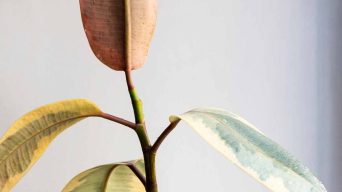The Rubber plant (Ficus elastica) is a popular houseplant because it’s easy to care for and can thrive indoors.
However, they are susceptible to root rot, which can kill the plant.
If you think your rubber plant has root rot, it’s essential to act quickly.
This article will show you how to save a rubber tree plant from root rot and prevent it from happening again.
What Is Root Rot?
Root rot is a disease that affects the roots of plants.
It is caused by various fungi, including Phytophthora, Pythium, and Rhizoctonia.
These fungi attack the plant’s root system, causing the roots to rot.
This can lead to a decline in plant health and eventually death.
What Causes Root Rot?
There are a few different things that can cause root rot in rubber plants.
The most common causes are:
Overwatering
Overwatering is the most common cause of root rot in rubber plants.
When the roots of a plant are constantly wet, they begin to break down and rot.
When a rubber plant is overwatered, the roots can’t get the oxygen they need to function correctly.
This causes the roots to rot and the plant to eventually die.
Overwatering happens when a plant is given too much water or when the soil around the plant doesn’t drain well.
Check the soil before watering it again if you think your rubber plant might be overwatered.
The soil should be dry to the touch before you water the plant.
Improper Drainage
Another common cause of root rot is improper drainage.
When the soil around a rubber tree plant doesn’t drain well, the roots can’t get the oxygen they need to function correctly.
This causes the roots to rot and the plant to eventually die.
Check the soil before watering it again if you think your rubber plant might have root rot.
The soil should be dry to the touch before you water the plant.
Fungal Infection
Rubber plants are also susceptible to fungal infections.
Fungal infections can cause the roots to rot and the plant to eventually die.
Fungi thrive in wet, humid conditions.
When rubber tree plants are overwatered, or the soil doesn’t drain well, the conditions are perfect for fungi to grow.
If you think your rubber plant might have a fungal infection, check the roots for signs of rot.
The plant likely has a fungal infection if you see any brown or black spots on the roots.
Root Damage
Root damage is another common cause of root rot.
When the roots of a plant are damaged, they can’t function properly and are more susceptible to diseases.
This causes the roots to rot and the plant to eventually die.
Root damage can be caused by several things, including:
Physical Damage
Physical damage to the roots can happen when the plant is transplanted.
When a plant is moved, the roots are disturbed and can be damaged.
This type of root damage can also happen when the plant is watered too vigorously or when the soil around the plant is compacted.
Chemical Damage
Chemical damage to the roots can happen when herbicides or other chemicals are applied to the soil around the plant.
These chemicals can damage the roots and cause them to rot.
What Does Rubber Plant Root Rot Look Like?
There are a few different things that you can look for to determine if your rubber plant (Ficus elastica) has root rot.
Here are some signs to look for:
Leaf Discoloration
One of the first things you might notice is that the leaves of your rubber plant start to change color.
The leaves might turn yellow, brown, or black.
The discoloration is a sign that the plant is not getting the nutrients it needs.
Leaf Drop
Another sign of root rot is leaf drop.
When the roots of a plant are rotted, the plant can’t get the nutrients it needs to stay alive.
As a result, the plant leaves will start to fall off.
Wilting
Wilting is another common sign of root rot.
When the roots of a plant are rotted, the plant can’t take up water from the soil.
As a result, the leaves of the plant will start to wilt.
Dry and Shriveled Leaves
If the leaves of your rubber plant are dry and shriveled, it’s a sign that the plant is not getting enough water.
This can happen for several reasons, but root rot is one of the most common.
When the roots of a rubber tree plant are rotted, the plant can’t take up water from the soil.
As a result, the plant leaves will start to dry out and shrivel.
Black or Brown Spots on the Leaves
If you see black or brown spots on the leaves of your rubber plant, it’s a sign that the plant has a fungal infection.
Fungal infections can cause the roots to rot and the plant to eventually die.
The spots might be small and isolated initially, but they will eventually spread.
If you see brown or black spots on your rubber plant leaves, it’s a good idea to check the roots for signs of rot.
Soft and Mushy Roots
Soft and mushy roots are the most obvious signs of root rot.
If you think your rubber plant has root rot, gently pull it out of the pot and check the roots.
If the roots are soft and mushy, it’s a sign that they are rotted.
You might also see brown or black spots on the roots.
These are signs of a fungal infection.
Soggy Soil
If the soil around your rubber plant is constantly soggy or wet, it’s a sign that the plant is not getting enough drainage.
When the roots of a plant are constantly wet, they can’t get the oxygen they need to function correctly.
As a result, the roots will start to rot, and the plant will eventually die.
Bad Smell
If you notice a bad smell coming from the soil around your rubber plant, it’s a sign that the plant has root rot.
When the roots of a plant are rotted, they release a foul odor.
The smell is often described as being similar to rotting meat.
Stunted Growth
If your rubber plant growth is stunted or stops growing altogether, it’s a sign that the plant is not getting the nutrients it needs.
When the roots of a plant are rotted, the plant can’t get the nutrients it needs to grow.
As a result, the plant’s growth will be stunted.
How To Treat Rubber Plant Root Rot
If you think your rubber plant has root rot, there are a few things you can do to try to save the plant.
Here is a step-by-step guide on how to treat rubber plant root rot:
1. Remove the Plant from the Pot
The first thing you need to do is remove the plant from the pot.
Gently pull the rubber plant out of the pot and examine the roots.
If the roots are soft and mushy, it’s a sign that they are rotted.
If the roots are firm and white, they are healthy.
2. Examine the Roots and Cut Away the Rot
Once you’ve removed the plant from the pot, examine the roots and cut away any that are soft and mushy.
Be sure to sterilize your knife before and after cutting away the rot to prevent the spread of disease.
3. Discard the Soil
Once you’ve removed the rotted roots, discard the soil.
Do not replant the rubber plant in the same soil.
If you do, you risk infecting the plant with root rot again.
4. Wash the Roots
After you’ve removed the rotted roots and discarded the soil, it’s time to wash the roots.
Gently rinse the roots with water to remove any dirt or debris.
5. Allow the Roots to Dry
Once you’ve washed the roots, allow them to dry before replanting the rubber plant.
This will help to prevent the spread of disease.
6. Clean the Pot
After you’ve removed the plant from the pot, be sure to clean the pot with soap and water.
This will help to prevent the spread of disease.
Ensure the pot has drainage holes, so the plant doesn’t sit in water.
7. Repot the Plant in Fresh Soil
Once you’ve cleaned the pot and allowed the roots to dry, you can repot the plant.
Be sure to use a fresh, sterile potting soil.
Use a well-draining potting soil mix to help prevent root rot.
8. Water the Plant
After you’ve repotted the plant, water it lightly.
Be sure to water the plant at the base, avoiding the leaves.
Water the plant until the potting mix is moist but not soggy.
9. Place the Plant in Indirect Sunlight
After you’ve watered the plant, place it in bright indirect light.
Rubber tree plants do best in bright light but can tolerate low light.
Avoid placing the plant in direct sunlight, as this can scorch the leaves.
10. Monitor the Plant
After you’ve repotted the plant and placed it in bright indirect sunlight, monitor the plant closely.
Be sure to water the plant when the potting mix begins to dry out.
If you see new growth, it’s a good sign that the plant is recovering.
Continue to monitor the plant and provide it with the proper care to help it fully recover.
How To Prevent Root Rot
You can do a few things to prevent root rot in your rubber plant (Ficus elastica).
Here are a few tips:
Use a Well-draining Potting Mix
Be sure to use a well-draining potting mix when you repot your rubber plant.
A well-draining potting mix will help to prevent the roots from sitting in water, which can cause root rot.
Water the Plant at the Base
Be sure to water the plant at the base, avoiding the leaves.
Watering the leaves can cause them to rot.
Water the plant until the potting mix is moist but not soggy.
Allow the Potting Soil to Dry Out Between Waterings
Be sure to allow the potting mix to dry out between waterings.
This will help to prevent root rot.
Use Pots with Drainage Holes
Be sure to use pots that have drainage holes.
Pots without drainage holes can cause the roots to sit in water, leading to root rot.
Place the Plant in Bright Indirect Light
Place the rubber plant in bright indirect light.
Direct sunlight can scorch the leaves, but too little light can cause the rubber plant to become leggy.
Provide Air Circulation
Be sure to provide air circulation around the plant.
Good air circulation will help to prevent fungal diseases, which can cause root rot.
Repot the Rubber Plant Every Few Years
Be sure to repot the rubber plant every few years.
This will help to refresh the potting mix and prevent the roots from becoming pot-bound.
The soil can also become compacted over time, leading to poor drainage and root rot.
By changing the potting mix and repotting the plant, you can help to prevent root rot.
Keep an Eye on the Plant
Be sure to keep an eye on your rubber plant.
If you see any signs of root rot, such as yellowing leaves or stunted growth, immediately take action.
The sooner you catch root rot, the easier it will be to treat.
Final Thoughts
When it comes to rubber plant care, preventing root rot is critical.
Be sure to plant your rubber tree in well-draining soil and water it only when the top inch of soil is dry.
Take action immediately if you notice any signs of root rot, such as yellowing leaves or mushy roots.
Cut away any affected roots and repot the plant in fresh, dry soil.
With proper care, your rubber tree will bounce back in no time.







